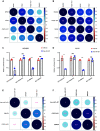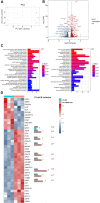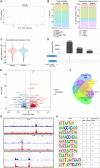FGD5-AS1 Is a Hub lncRNA ceRNA in Hearts With Tetralogy of Fallot Which Regulates Congenital Heart Disease Genes Transcriptionally and Epigenetically
- PMID: 34046402
- PMCID: PMC8144506
- DOI: 10.3389/fcell.2021.630634
FGD5-AS1 Is a Hub lncRNA ceRNA in Hearts With Tetralogy of Fallot Which Regulates Congenital Heart Disease Genes Transcriptionally and Epigenetically
Abstract
Heart development requires robust gene regulation, and the related disruption could lead to congenital heart disease (CHD). To gain insights into the regulation of gene expression in CHD, we obtained the expression profiles of long non-coding RNAs (lncRNAs) and messenger RNAs (mRNAs) in 22 heart tissue samples with tetralogy of Fallot (TOF) through strand-specific transcriptomic analysis. Using a causal inference framework based on the expression correlations and validated microRNA (miRNA)-lncRNA-mRNA evidences, we constructed the competing endogenous RNA (ceRNA)-mediated network driven by lncRNAs. Four lncRNAs (FGD5-AS1, lnc-GNB4-1, lnc-PDK3-1, and lnc-SAMD5-1) were identified as hub lncRNAs in the network. FGD5-AS1 was selected for further study since all its targets were CHD-related genes (NRAS, PTEN, and SMAD4). Both FGD5-AS1 and SMAD4 could bind with hsa-miR-421, which has been validated using dual-luciferase reporter assays. Knockdown of FGD5-AS1 not only significantly reduced PTEN and SMAD4 expression in HEK 293 and the fetal heart cell line (CCC-HEH-2) but also increased the transcription of its interacted miRNAs in a cell-specific way. Besides ceRNA mechanism, RNAseq and ATACseq results showed that FGD5-AS1 might play repression roles in heart development by transcriptionally regulating CHD-related genes. In conclusion, we identified a ceRNA network driven by lncRNAs in heart tissues of TOF patients. Furthermore, we proved that FGD5-AS1, one hub lncRNA in the TOF heart ceRNA network, regulates multiple genes transcriptionally and epigenetically.
Keywords: FGD5-AS1; congenital heart disease; gene expression; lncRNA; tetralogy of Fallot.
Copyright © 2021 Zhang, Gao, Zhang, Zhang, Xiang, Fu, Wang and Xu.
Conflict of interest statement
The authors declare that the research was conducted in the absence of any commercial or financial relationships that could be construed as a potential conflict of interest.
Figures





References
-
- Camenisch T. D., Spicer A. P., Brehm-Gibson T., Biesterfeldt J., Augustine M. L., Calabro A., Jr., et al. (2000). Disruption of hyaluronan synthase-2 abrogates normal cardiac morphogenesis and hyaluronan-mediated transformation of epithelium to mesenchyme. J. Clin. Invest. 106 349–360. 10.1172/JCI10272 - DOI - PMC - PubMed
LinkOut - more resources
Full Text Sources
Other Literature Sources
Molecular Biology Databases
Research Materials
Miscellaneous

